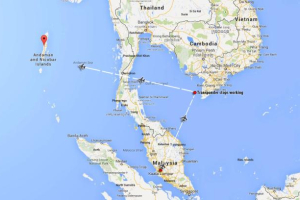Australian authorities believe Malaysia Arlines Flight 370 probably flew into the Southern Indian Ocean while on autopilot with an unresponsive crew, revealing new information about what they believe happened prior to the plane's strange disappearance.
"It is highly, highly likely that the aircraft was on autopilot, otherwise it could not have followed the orderly path that had been identified through the satellite's sightings," Australian Deputy Prime Minister Warren Truss told reporters in Canberra, CNN reports.
When asked whether the autopilot would have been manually turned on, Martin Dolan, chief commissioner of the Australian Transport Safety Bureau stated that "the basic assumption would be that if the autopilot is operational it's because it's been switched on."
In addition, experts say the unresponsive nature of those aboard the plane was likely due to all 239 passengers and crew becoming unresponsive, possibly after being deprived of oxygen, based on the plane's steady altitude, its loss of radio communications, and other factors, the Wall Street Journal reports.
Such a scenario "appeared to best fit the available evidence for the final period of MH370's flight," stated a report titled "MH370-Definition of Underwater Search Areas," referencing prior occasions where crews had become unresponsive due to hypoxia.
While such a scenario is more likely than others, such as the plane's systems malfunctioning, a stall or a sudden loss of flight controls, the report notes that the assumption was "made for the purpose of defining a search area and there is no suggestion that the investigation authority will make similar assumptions."
Hypoxia occurs when a plane loses air pressure and the pilots, lacking adequate oxygen, become confused and incapable of performing even basic functions.
However, many are still left wondering why Flight 370 deviated sharply from its planned route to Beijing from Kuala Lumpur, or what might have caused the sudden lack of oxygen.
According to the report, the Australian Transport Safety Bureau has moved the search area for the third time in as many months, restarting in August nearly 600 miles south of the previous underwater focus.
"Specialists have analyzed satellite communications information-information which was never initially intended to have the capability to track an aircraft-and performed extremely complex calculations," said Truss. "The new priority area is still focused on the seventh arc, where the aircraft last communication with the satellite."
Li Xinmao, whose daughter, Lin Yan was among those on the flight, says he is frustrated with the way the operation has been handled thus far, but holds onto hope that his daughter may still be alive.
"I still think the plane may land on some island or land, there is still some hope for our relatives," he told USA Today.





















